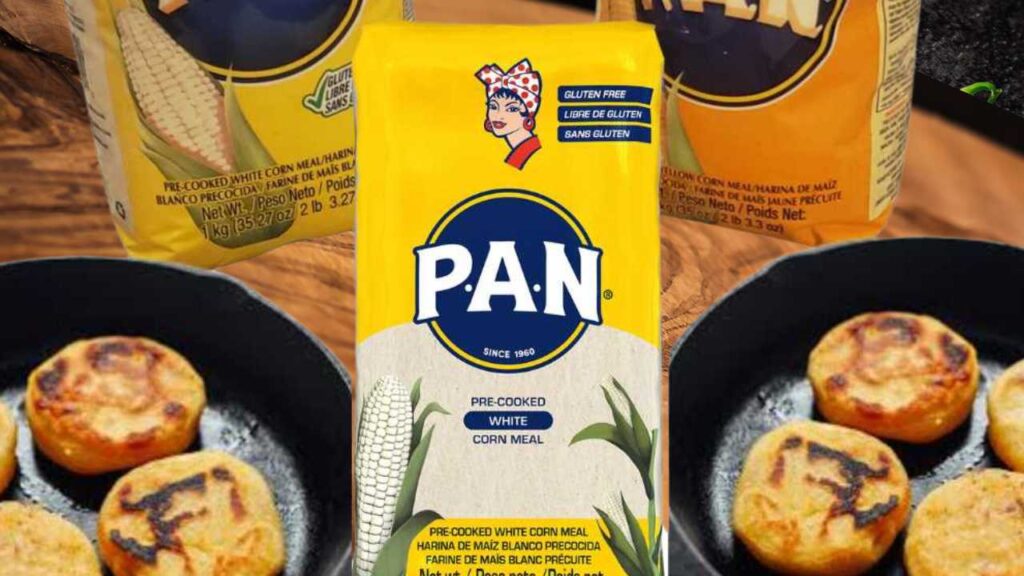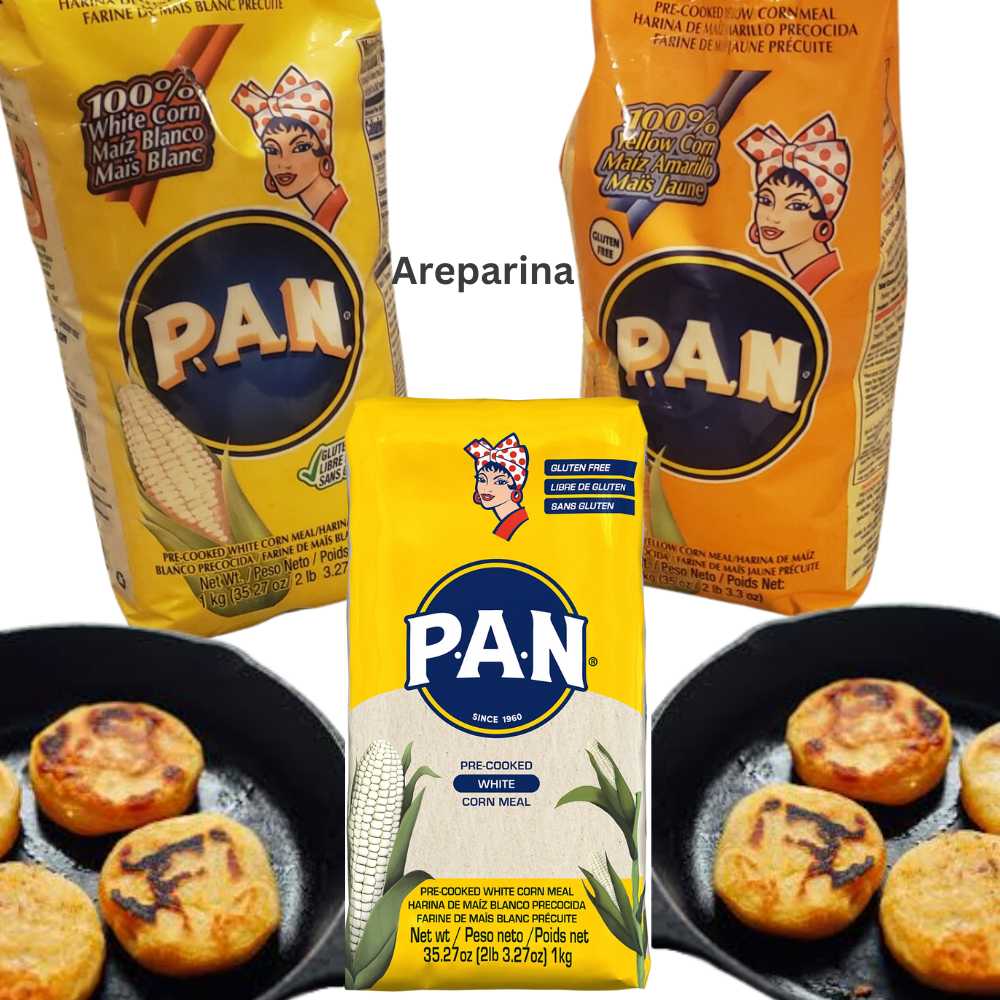Areparina is a pre-cooked cornmeal that acts as the essential base for preparing arepas, a staple dish in Colombian cuisine. This adaptable flour is crafted from dried corn kernels that are cooked, finely ground, and dried to create a smooth powder. What makes Areparina unique is its convenience and the characteristic texture it brings to arepas, giving them a crispy exterior and a tender interior. Its user-friendly nature and distinctive qualities have made it a household favorite in Colombia, enabling the swift preparation of one of the nation’s most cherished culinary delights.

Key Ingredient: Understanding Areparina
Step 1: What is Areparina?
Areparina is a pre-cooked cornmeal that plays a vital role in Colombian cuisine. Unlike regular cornmeal, Areparina undergoes a unique processing method where the corn is cooked, finely ground, and dried, making it highly convenient for quick meal preparation. This distinct process results in a flour with a soft texture and mild flavor, perfect for creating various traditional dishes.
Step 2: A Historical Overview
The story of Areparina dates back to Colombia’s indigenous peoples, who cultivated and processed maize thousands of years ago. Over centuries, their techniques evolved, culminating in the production of Areparina. Today, it stands as a cornerstone of Colombian culinary heritage, featuring prominently in dishes such as arepas, empanadas, and tamales.
Step 3: What Makes Areparina Special?
One of Areparina’s standout qualities is its versatility. The pre-cooked nature of the flour allows it to be easily rehydrated and shaped into various forms, from flatbreads to stuffed pastries. Additionally, its subtly sweet and nutty flavor enhances recipes without overshadowing other ingredients.
Step 4: Nutritional Benefits of Areparina
Areparina isn’t just about flavor—it’s also packed with essential nutrients. Rich in carbohydrates, dietary fiber, vitamins, and minerals, it provides a wholesome addition to any meal. For many Colombians, Areparina is a key dietary staple that supports energy and overall nutrition.
Step 5: Culinary Applications
In Colombian kitchens, Areparina is most commonly used to make arepas, a versatile flatbread that can be grilled, baked, or fried. These can be enjoyed plain or filled with cheese, meats, or vegetables. Additionally, Areparina features in recipes like almojábanas (cheese bread) and mantecada (corn cake), showcasing its adaptability and importance in Colombian cuisine.
Areparina for International Cooks: A Simplified Guide
For those unfamiliar with Areparina, it can be likened to pre-cooked corn flour, similar to masa harina or instant polenta. However, its fine texture and unique processing give it a distinctive quality. When shopping, look for packaging labeled explicitly for making arepas to ensure you’re purchasing the right type of flour. Experimenting with Areparina opens up endless possibilities to recreate authentic Colombian dishes at home.
Areparina vs. Masarepa: Key Differences and Uses
Though both Areparina and Masarepa are pre-cooked corn flours used in Latin American cuisine, they differ in origin, texture, and application.
| Feature | Areparina | Masarepa |
|---|---|---|
| Origin | Primarily Colombian cuisine | Mostly Venezuelan cuisine |
| Texture | Finely ground | Slightly coarser |
| Flavor | Mildly sweet and nutty | Subtly corn-like |
| Best Uses | Arepas, almojábanas, mantecada | Arepas, empanadas, hallacas |
By understanding these differences, cooks can select the right flour for specific recipes and achieve the best results.
Traditional Recipes with Areparina
Making Arepas
Ingredients:
- 2 cups Areparina
- 2.5 cups warm water
- 1 teaspoon salt
- 1 tablespoon oil (optional)
Instructions:
- Combine Areparina, salt, and warm water in a bowl, mixing until a smooth dough forms.
- Rest the dough for 5 minutes.
- Shape into discs and cook on a heated skillet for 5-7 minutes per side.
- Serve plain or stuffed with your favorite fillings.
Preparing Almojábanas
Ingredients:
- 1 cup Areparina
- 1 cup grated cheese
- 1 tablespoon sugar
- 1 teaspoon baking powder
- 1 egg
- ¼ cup milk
Instructions:
- Mix Areparina, cheese, sugar, and baking powder.
- Whisk egg and milk together, then combine with dry ingredients.
- Shape into small balls, flatten, and bake at 375°F for 15-20 minutes.
Crafting Empanadas
Ingredients:
- 2 cups Areparina
- 2 cups warm water
- ½ teaspoon salt
- Filling of choice
Instructions:
- Combine Areparina, salt, and water to form dough.
- Flatten small portions into circles, add filling, and seal.
- Fry in hot oil until golden and crispy.
Areparina Recipe: A Step-by-Step Guide to Making Arepas
Ready to try your hand at making arepas? Here’s a step-by-step guide to help you craft this Colombian favorite with ease:
Ingredients:
- 2 cups Areparina (pre-cooked corn flour)
- 2 ½ cups warm water
- 1 teaspoon salt
- 1 tablespoon vegetable oil
Instructions:
Mix Ingredients: Start by placing Areparina and salt into a large mixing bowl. Slowly pour in warm water, mixing with your hands until the dough comes together. Knead the dough for a few minutes until it’s smooth and pliable.
Form the Arepas: Divide the dough into smaller portions, then roll each one into a ball. Flatten each ball into a disc, approximately ½ inch thick.
Cook the Arepas: Heat a tablespoon of oil in a cast-iron skillet or flat griddle over medium heat. Add the arepas to the skillet, cooking each side for about 5-7 minutes until golden brown and fully cooked through.
Serving: Serve your arepas hot with your preferred toppings or fillings. They pair wonderfully with cheese, avocado, or scrambled eggs for a satisfying meal.
Where to Find Areparina: A Guide to Locating Authentic Flour
Sourcing authentic Areparina flour might be a challenge if you don’t live in Colombia. However, with the growing popularity of online shopping and specialty food stores, it’s becoming easier to find.
If you’re in a city with Latin American grocery stores, these are often the best places to find Areparina along with other essential Colombian ingredients. These stores are your direct link to authentic, hard-to-find products that larger supermarkets might not carry.
Alternatively, if local options are limited, online platforms like Amazon or other food specialty sites offer a range of Areparina brands that can be shipped directly to your home. Be sure to check reviews and select a trusted brand to ensure you’re getting quality flour.
Areparina Colombiana: The Cultural Importance of Areparina
In Colombia, Areparina is much more than just a cooking ingredient—it’s a cultural symbol. Its presence in kitchens throughout the country highlights the deep connection between food and the Colombian way of life.
For many, preparing arepas is a communal activity that brings family and friends together in the kitchen. This shared cooking experience fosters community, making Areparina a symbol of unity and connection. From casual family dinners to festive celebrations, Areparina plays an important role in Colombian cuisine, representing tradition and the bond created through food.
The cultural significance of Areparina reflects how food can serve as more than sustenance. It’s a way to preserve culture, bring people together, and maintain cherished traditions.
Finding Areparina Locally and Online
If you’re eager to try Areparina in your own cooking, there are several ways to find it, depending on where you live. For those in areas with a strong Latin American community, local grocery stores that specialize in Latin food often carry Areparina. Don’t hesitate to ask store staff if you’re having trouble finding it.
For those unable to locate Areparina in their local stores, online shopping is a great option. Many specialty retailers offer this essential Colombian flour, with shipping options that deliver worldwide. Just ensure you’re purchasing from a reliable source to guarantee authenticity.
Areparina Substitutes: Alternatives If You Can’t Find It
While Areparina is the traditional choice for Colombian dishes, there are alternatives for those who may not be able to source it easily. These substitutes can still deliver satisfying results and allow you to experiment with Colombian cuisine.
Masa harina, commonly used in Mexican cooking, is a popular substitute. While it has a slightly different texture, it works well for making arepas and other corn-based dishes. It’s often available at most grocery stores and provides a decent alternative.
Polenta or cornmeal can also serve as substitutes but require extra preparation, such as soaking or cooking, to achieve the desired consistency. While these alternatives won’t exactly replicate Areparina’s flavor or texture, they can still create delicious and enjoyable dishes.
Is Areparina Gluten-Free? Exploring Its Nutritional Benefits
For individuals with gluten sensitivities or celiac disease, Areparina is a great choice since it is naturally gluten-free. Since Areparina is made entirely from corn, it contains no wheat or gluten-based ingredients, making it suitable for those on gluten-free diets.
Areparina is also a nutritious option, providing a rich source of fiber and essential vitamins. With its versatility and health benefits, it’s a fantastic addition to your kitchen, whether you’re following a gluten-free diet or simply looking to try new flavors.
Nutritional Profile of Areparina
| Nutrient | Amount per 100g | % Daily Value* |
|---|---|---|
| Calories | 365 kcal | 18% |
| Protein | 8.68 g | 17% |
| Total Fat | 4.74 g | 6% |
| Saturated Fat | 0.67 g | 3% |
| Carbohydrates | 78.92 g | 29% |
| Dietary Fiber | 7.3 g | 26% |
| Sugars | 0.64 g | – |
| Calcium | 6 mg | <1% |
| Iron | 2.86 mg | 16% |
| Magnesium | 127 mg | 32% |
\*Percent Daily Values are based on a 2,000-calorie diet. Your daily values may be higher or lower depending on your calorie needs.
The Evolution of Areparina: From Colombia’s Heart to Global Kitchens
Areparina, a traditional Colombian flour made from corn, has deep roots in the country’s rich agricultural history. This essential ingredient traces its origins to the indigenous communities of Colombia, who cultivated corn as a vital crop. Over centuries, Areparina has transformed from a staple in indigenous diets to a cornerstone of Colombian cuisine, becoming synonymous with the beloved arepa.
In Colombia, Areparina is more than just an ingredient—it’s a part of the nation’s cultural identity. For generations, families have relied on this flour to create a wide range of comforting and celebratory dishes. With the advent of globalization, Areparina has transcended borders and is now a prized ingredient in international kitchens, bringing the flavors of Colombia to the world.
Cooking with Areparina: Beyond the Classic Arepas
Though Arepas are the signature dish made with Areparina, this versatile flour lends itself to numerous other mouthwatering recipes. Here are a few creative ideas for incorporating Areparina into your cooking:
Areparina Empanadas
Ingredients:
- 2 cups Areparina
- 1 ½ cups warm water
- ¼ teaspoon salt
- Filling of your choice (meat, cheese, vegetables, etc.)
Instructions:
- Prepare the Dough: Combine Areparina, warm water, and salt to form a smooth dough.
- Shape the Empanadas: Divide the dough into equal portions, flatten them into circles, and place your filling in the center. Fold the dough over the filling and seal the edges.
- Cook the Empanadas: Fry the empanadas in hot oil until golden and crispy, or bake them in a preheated oven at 375°F (190°C) for 20 minutes.
Areparina Pancakes
Ingredients:
- 1 cup Areparina
- 1 cup milk
- 1 egg
- 2 tablespoons sugar
- 1 teaspoon baking powder
- A pinch of salt
Instructions:
- Prepare the Batter: In a bowl, whisk together Areparina, milk, egg, sugar, baking powder, and salt until smooth.
- Cook the Pancakes: Heat a non-stick skillet over medium heat. Pour batter to form pancakes and cook until bubbles form. Flip and cook until both sides are golden brown.
Areparina Bread
Ingredients:
- 3 cups Areparina
- 1 ½ cups warm water
- 1 tablespoon sugar
- 1 tablespoon dried yeast
- ¼ teaspoon salt
Instructions:
- Activate the Yeast: Dissolve sugar in warm water, sprinkle yeast over it, and let it sit until frothy.
- Make the Dough: Combine Areparina and salt in a large bowl. Add the yeast mixture and knead the dough until smooth.
- Let it Rise: Cover and allow the dough to rise for about an hour.
- Shape and Bake: Form the dough into a loaf or rolls, bake at 375°F (190°C) for 25-30 minutes until golden brown.
Areparina Tortillas
Ingredients:
- 2 cups Areparina
- 1 ½ cups warm water
- ¼ teaspoon salt
Instructions:
- Prepare the Dough: Mix Areparina, warm water, and salt until a smooth dough forms.
- Shape the Tortillas: Divide the dough into balls, flatten them into thin circles.
- Cook the Tortillas: Heat a skillet over medium-high heat and cook each tortilla for 1-2 minutes per side until lightly browned.
These recipes demonstrate the vast potential of Areparina, offering diverse options beyond the classic arepas. Let your creativity run wild in the kitchen as you explore new ways to enjoy this essential Colombian ingredient.
Conclusion
Areparina is not just a pantry staple—it’s a key to unlocking the heart of Colombian culture. Understanding the significance of this flour, both in its culinary applications and its cultural context, helps us appreciate its role in shaping the flavors of Colombia. Whether you’re an experienced chef or a beginner, Areparina opens up a world of possibilities in your cooking.
For anyone interested in experiencing the richness of Colombian cuisine, Areparina offers a direct connection to the flavors, traditions, and community spirit of Colombia. As you try new recipes, you’ll not only explore the versatility of this flour but also contribute to preserving a cherished culinary legacy.
Frequently Asked Questions (FAQs)
Q: Where can I find Areparina?
A: Areparina is available at many Latin American grocery stores and can be found at select online retailers. Look for it in the flour or international food section.
Q: Can Areparina be used for gluten-free recipes?
A: Yes! Areparina is naturally gluten-free, making it an excellent option for those with gluten sensitivities. However, ensure that it hasn’t come into contact with gluten during processing.
Q: How should I store Areparina?
A: Store Areparina in an airtight container in a cool, dry place, away from sunlight. For long-term storage, freezing it in airtight bags can help prevent spoilage.
Q: What other dishes can I make with Areparina?
A: Areparina is incredibly versatile! You can use it to make corn fritters, savory empanadas, sweet corn cakes, and more. Its distinct flavor and texture elevate a variety of recipes.
Q: Is Areparina the same as masa harina?
A: While similar, Areparina and masa harina are not identical. Masa harina is primarily used for tortillas and tamales, while Areparina is specifically for arepas and other Colombian specialties. You can substitute masa harina if needed, but the results may vary.
Q: Does Areparina offer any nutritional benefits?
A: Yes, Areparina is made from corn, making it a great source of fiber and essential vitamins. Incorporating it into your diet can help support a healthy and balanced eating plan.
If you have any other questions or need recipe ideas, feel free to reach out! Enjoy your culinary adventures with Areparina.

